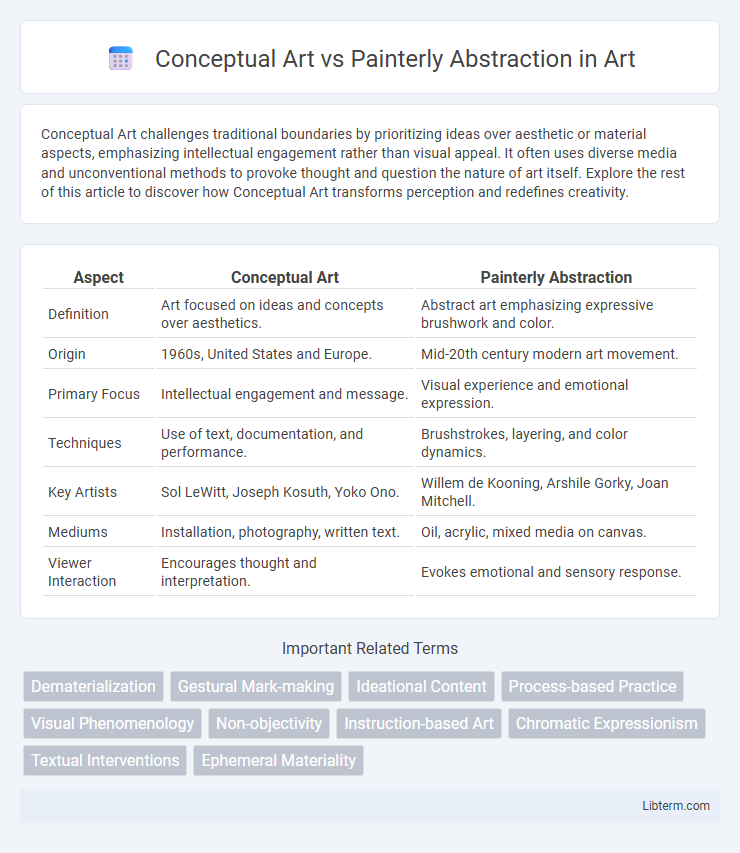Conceptual Art challenges traditional boundaries by prioritizing ideas over aesthetic or material aspects, emphasizing intellectual engagement rather than visual appeal. It often uses diverse media and unconventional methods to provoke thought and question the nature of art itself. Explore the rest of this article to discover how Conceptual Art transforms perception and redefines creativity.
Table of Comparison
| Aspect | Conceptual Art | Painterly Abstraction |
|---|---|---|
| Definition | Art focused on ideas and concepts over aesthetics. | Abstract art emphasizing expressive brushwork and color. |
| Origin | 1960s, United States and Europe. | Mid-20th century modern art movement. |
| Primary Focus | Intellectual engagement and message. | Visual experience and emotional expression. |
| Techniques | Use of text, documentation, and performance. | Brushstrokes, layering, and color dynamics. |
| Key Artists | Sol LeWitt, Joseph Kosuth, Yoko Ono. | Willem de Kooning, Arshile Gorky, Joan Mitchell. |
| Mediums | Installation, photography, written text. | Oil, acrylic, mixed media on canvas. |
| Viewer Interaction | Encourages thought and interpretation. | Evokes emotional and sensory response. |
Defining Conceptual Art
Conceptual Art emphasizes the idea or concept behind the artwork over traditional aesthetic and material concerns, prioritizing intellectual engagement rather than visual appeal. It often employs language, documentation, and non-traditional mediums to challenge conventional art forms and question authorship and originality. Distinct from Painterly Abstraction, which centers on expressive brushwork and color fields, Conceptual Art foregrounds meaning and context as the primary artistic elements.
Understanding Painterly Abstraction
Painterly abstraction emphasizes expressive brushwork, texture, and color to evoke emotion and spontaneity in the artwork. Unlike conceptual art, which prioritizes ideas and intellectual engagement, painterly abstraction focuses on visual perception and the physicality of painting itself. Key artists such as Willem de Kooning and Joan Mitchell exemplify this movement through dynamic, gestural compositions that challenge traditional representation.
Historical Origins and Evolution
Conceptual Art emerged in the 1960s as a radical shift emphasizing ideas over traditional aesthetic and material concerns, drawing from earlier movements like Dada and Fluxus to challenge the commodification of art. Painterly Abstraction originated in the early 20th century, evolving through Abstract Expressionism with artists like Jackson Pollock and Willem de Kooning focusing on spontaneous brushwork and emotional intensity. While Conceptual Art prioritizes intellectual engagement and often uses text and installation, Painterly Abstraction centers on the sensory experience of color and form through dynamic brushstrokes.
Key Artists and Influential Works
Conceptual Art, championed by artists like Sol LeWitt and Joseph Kosuth, emphasizes ideas over visual form, as seen in LeWitt's "Wall Drawings" and Kosuth's "One and Three Chairs," which challenge traditional aesthetic values. Painterly Abstraction, represented by Willem de Kooning and Richard Diebenkorn, focuses on dynamic brushwork and color fields exemplified in de Kooning's "Woman" series and Diebenkorn's "Ocean Park" paintings, highlighting emotional expression through form and texture. These movements contrast by prioritizing intellectual concepts versus sensory experience, shaping modern art's dialogue on meaning and medium.
Core Philosophies and Methods
Conceptual Art emphasizes ideas and concepts over aesthetic or material concerns, often using text, performance, or documentation as primary mediums to challenge traditional notions of art. Painterly Abstraction prioritizes expressive brushwork, color, and form to evoke emotion and sensory experience, focusing on the physical act of painting itself. Core to Conceptual Art is the dematerialization of the art object, while Painterly Abstraction embraces the tactile process and visual impact of paint on canvas.
Visual Language: Ideas vs. Aesthetics
Conceptual Art prioritizes the communication of ideas and intellectual engagement over traditional aesthetic qualities, using visual elements as vehicles to convey complex concepts. Painterly Abstraction emphasizes the sensory experience through expressive brushwork, color, and form, celebrating the aesthetics and emotional resonance of the medium itself. The visual language of Conceptual Art challenges viewers to interpret meaning beyond visual pleasure, whereas Painterly Abstraction invites immersion in the tactile and visual dynamics of paint.
Audience Engagement and Interpretation
Conceptual Art emphasizes ideas over visual form, engaging audiences through intellectual inquiry and open-ended interpretation, often requiring active participation to decode meaning beyond the aesthetic. Painterly Abstraction invites viewers to experience emotion and sensory reactions through dynamic brushwork and color fields, promoting a more immediate, subjective response rooted in visual perception. Audience engagement in Conceptual Art hinges on cognitive interaction and context, while Painterly Abstraction relies on emotional resonance and formal appreciation.
Materials and Techniques Compared
Conceptual Art prioritizes ideas over aesthetic objects, often utilizing non-traditional materials such as text, found objects, and performance to convey meaning, emphasizing the concept rather than craftsmanship. Painterly Abstraction focuses on the physical application of paint, employing techniques like gestural brushstrokes, color fields, and textured surfaces with traditional materials such as oil and acrylic on canvas to evoke emotion and visual experience. The distinction lies in Conceptual Art's dematerialization of the art object versus Painterly Abstraction's celebration of materiality and painterly technique.
Critical Reception and Art Market Impact
Conceptual Art, emphasizing ideas over visual form, received critical acclaim for challenging traditional art boundaries, yet faced skepticism regarding its market value due to its intangible nature. Painterly Abstraction, characterized by expressive brushwork and emotional intensity, was praised for revitalizing abstract expressionism and enjoyed strong demand among collectors and galleries. The art market responded by valuing Painterly Abstraction's tangible aesthetics higher, while Conceptual Art found niche appreciation with institutional collectors and contemporary art fairs.
Future Directions and Contemporary Relevance
Conceptual Art prioritizes ideas and intellectual engagement over aesthetic form, influencing contemporary practices that integrate technology and interdisciplinary approaches. Painterly Abstraction continues to evolve through dynamic brushwork and color exploration, maintaining its relevance in expressing emotional depth and sensory experience. Future directions suggest a convergence where conceptual frameworks inform abstract techniques, fostering innovative, hybrid art forms in the modern artistic landscape.
Conceptual Art Infographic

 libterm.com
libterm.com